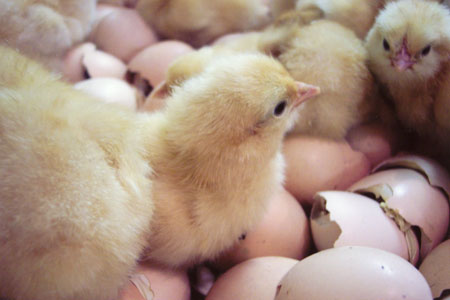
Whether or not using more than one incubator makes sense depends on how much hatching you plan to do and how many different chicken breeds or poultry species you wish to hatch. Most incubators for home use are designed for batch hatching. Sometimes, though, you might not want to wait until the eggs hatch before setting more. In that case you could use your incubator for continuous hatching, or you could set up a separate hatcher. Each method has advantages and disadvantages.
Batch Hatching
Batch hatching is the most common incubation method used by backyard poultry keepers. This method is also known as single-stage incubation or all-in all-out incubation. Using this method, you put in all the eggs at the same time, then wait until they hatch before setting a new batch.
An advantage to batch hatching is that you can thoroughly clean the empty incubator after each hatch. Another advantage is that you can optimize your success rate by adjusting the temperature, humidity, and ventilation as incubation progresses to the hatching stage.
Single-stage incubation is ideal for hatching a few birds once a year. They might be all chicken eggs, or you might mix species by staggering your schedule. For instance, you might set guinea eggs the week before adding chicken eggs, since the incubation period for guineas is about one week longer than for chickens.
Another way to use single-stage incubation is to hatch one breed or mating at a time and brood them separately. Or you might hatch one species at a time — such as chicken eggs in one batch and duck eggs in the next batch — to accommodate their differing incubation periods and hatching requirements.
Batch hatching is a disadvantage if you wish to maximize the number of eggs hatched. If, for instance, you have highly seasonal layers, or highly valuable birds, you might not want to wait the full term for each hatch before setting the next batch.
Continuous Hatching
Continuous hatching, or multi-stage incubation, means groups of eggs are placed in the incubator at different times and therefore hatch at different times. It is the typical backyard scenario for cabinet incubators. A common cabinet model has three incubation trays and, below them, a single hatching tray.
This setup is essentially designed for hatching chicken eggs, because it allows you to fill one tray each week. Then, starting in 21 days, chicks will hatch once a week on the hatching tray for as long as you keep refilling the empty incubation trays. An advantage is that you can hatch more birds and on a regular basis.
Continuous hatching is possible (though not practical) with a tabletop incubator in which eggs must be turned manually. But is not a handy option for an incubator with automatic turning where, as hatching time approaches, the turner must be removed for some but not all of the eggs.
Another problem is that the eggs that are due to hatch require higher humidity than those under incubation. If the humidity is adjusted for the hatch, it will be too high for the eggs still under incubation. If it is adjusted for incubation, it will be too low for a good hatch.
Yet another disadvantage is that hatching debris — broken shells, chick fluff, and embryo wastes — builds up and must be dealt with while some eggs are still under incubation. Despite your best efforts, you can’t thoroughly sanitize an incubator with eggs in it. As pathogens build up, the hatching rate gradually declines. So if you plan to hatch lots of eggs, you might consider using a separate hatcher.
Separate Hatcher
A hatcher is a unit into which eggs are moved from the incubator a couple of days before they are due to hatch. The hatcher is essentially an incubator with no automatic egg turner. So using this method, you would have one incubator with a turner used as a setter, and a second incubator without a turner as the hatcher.
Along with allowing you to hatch greater numbers of eggs, having a separate hatcher offers the same important advantages as batch hatching. You can optimize the environment for each hatch, then thoroughly clean out hatching debris after the hatch. Compared to continuous hatching, using a separate hatcher vastly improves the hatch rate.
For more incubation information see “Selecting the Best Chicken Egg Incubator” and “Tips for Hatching Chicken Eggs in an Incubator.”
And that’s today’s news from the Cackle Coop.
Gail Damerow is the author of Hatching and Brooding Your Own Chicks: Chickens, Turkeys, Ducks, Geese, Guinea Fowl.

